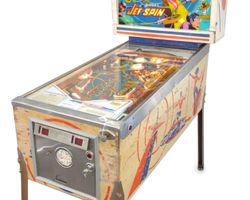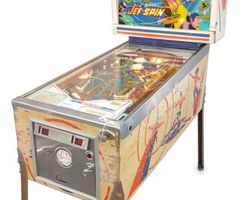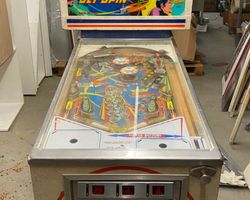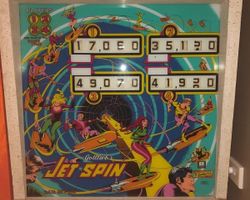Jet Spin
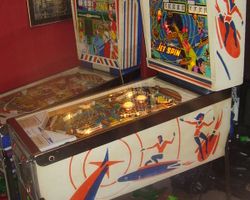
Average Prices: USD $300 to $1,000
Produced: August, 1977
Production Run: 4,761 units
Machine Type: Electro-mechanical
Players: 4
Design by: Ed Krynski
Art by: Gordon Morison
"Jet Spin," an electro-mechanical (EM) pinball machine from D. Gottlieb & Company, emerged in August 1977, a period when the industry was on the cusp of a technological shift towards solid-state electronics. Despite the impending change, Gottlieb continued to innovate within the EM framework, producing machines that offered deep gameplay and engaging experiences. "Jet Spin," designated Model Number 403, stands as a testament to this era, embodying the creative design principles that defined Gottlieb’s output.
The machine's creation was a collaborative effort, with Ed Krynski handling the game design and Gordon Morison bringing the vivid artwork to life. Morison’s artistic vision for "Jet Spin" leaned into a vibrant, futuristic fantasy theme, depicting figures in jet-powered flight, which resonated with the era’s fascination with space and adventure. This visual appeal was a significant aspect of the machine’s identity. Produced for both domestic and export markets, "Jet Spin" saw a confirmed production run of 5,238 units. Of these, 1,497 were destined for domestic operators, while a substantial 3,393 units were exported, indicating the machine's global reach. An additional 348 sample games were produced, as documented in internal Gottlieb records. Operators acquired "Jet Spin" for $1,295 FOB Chicago upon its release, a competitive price point for a four-player EM machine at the time. Notably, a two-player iteration of this game, featuring a similar design but with fewer score reels and a modified backglass, was released as "Super Spin." This design also offered the flexibility to be converted for Add-A-Ball play, a common feature in EM machines of the time to extend gameplay in certain locales.
Distinctive Features and Visuals
"Jet Spin" distinguishes itself through a suite of mechanical features and a cohesive artistic presentation that work in tandem to create an interactive experience. Central to its design are two flippers, two pop bumpers, and two slingshots, forming the core interactive elements. Beyond these standard components, the machine incorporates several specialized targets that define its unique gameplay. Three standup targets provide straightforward scoring opportunities, while a kick-out hole offers a satisfying reward for precision shots, returning the ball into play with a flourish.
The defining elements of "Jet Spin," however, are its three Roto-targets and a single Vari-target. The Roto-targets, cylindrical spinning targets, offer variable scoring based on their current orientation, injecting an element of unpredictability and strategic shot-making into the game. The Vari-target, a resilient target that recedes based on the force of impact, adds another layer of dynamic play; hitting it with sufficient power can activate special features or bonuses, prompting players to adjust their shot strength. These mechanical innovations are integrated seamlessly into the game’s overall design.
Gordon Morison's artwork is a standout component, praised for its colorful and brilliant execution. The backglass, in particular, captures attention with its "pure 70s and comic-like" aesthetic, featuring characters in unique "space leotards" engaged in futuristic pursuits. While some have found the aesthetic of the characters or the complexity of the backglass a point of discussion, its overall impact is widely recognized as visually striking and distinct, contributing significantly to the machine’s identity. The playfield artwork mirrors this vibrant style, utilizing "super colors" that maintain visual appeal despite the machine's age. Accompanying the visual spectacle are the classic Gottlieb chimes, which provide the machine's soundscape. These three-chime units produce a clear, resonant sound that marks key scoring events and reinforces the tactile feedback of gameplay, often described as "peeling beautifully."
Playfield Engineering and Layout
The playfield of "Jet Spin" is engineered with an asymmetrical layout, a deliberate design choice that enhances shot variety and player engagement. This "cool off-center" arrangement diverges from symmetrical designs, offering a diverse array of shot angles and paths, ensuring that no two shots feel identical. The primary objective for players often revolves around skillfully navigating shots towards the three Roto-targets, each positioned to demand a different approach. Precision is further tested by the three standup targets and the strategically placed Vari-target, which can be hit repeatedly for increasing rewards or to light up special features. The kick-out hole adds an element of risk and reward, often positioned in a way that requires a precise shot to activate and gain its bonus.
The design philosophy behind "Jet Spin's" layout leans into the concept of a "marksman's EM," emphasizing accuracy and control over raw power. The playfield is designed to challenge players to identify and execute specific shots, rather than merely flailing the ball. This is evident in the interaction required to advance game objectives and score significant points. While the main flippers are generally considered strong enough to execute precise shots across the playfield, some players have observed an occasional inconsistency in their ability to cradle or trap the ball. The aesthetic integration of the artwork across the playfield is robust; the vibrant colors and detailed illustrations complement the mechanical features, guiding the player's eye and enhancing the thematic immersion. Lighting, delivered through incandescent bulbs typical of EM machines, illuminates key targets and scoring areas, providing visual cues that are vital for strategic play.
Engaging Gameplay Dynamics
Gameplay on "Jet Spin" is characterized by its fast pace and a challenging, yet highly engaging, loop that encourages repeated plays. The maximum displayed score per player is 199,990 points, pushing players to optimize every shot. The core progression revolves around hitting the various targets to accumulate points and advance towards bonuses and specials. The Roto-targets, for instance, provide dynamic scoring opportunities, their value changing as they spin, urging players to time their shots for maximum impact. The Vari-target, through its variable resistance, offers a direct path to specials; a powerful hit might instantly light up a special, providing a direct and satisfying reward.
One of "Jet Spin's" defining gameplay mechanics is its end-of-ball bonus. Players accrue bonus points during play, which are then tallied and added to their score at the end of each ball. This system creates a tangible sense of progression throughout each turn. However, this bonus mechanism also presents one of the game's noted quirks. Once the bonus is maxed out, typically at 15,000 points, subsequent hits that would normally contribute to the bonus can feel less impactful, as there is no immediate in-play method to collect or reset this maxed bonus. This can, for some players, reduce the incentive for hitting certain targets after the bonus ceiling has been reached, making some aspects of the endgame feel less dynamic. Despite this, the intricate interaction between the Roto-targets, Vari-target, and other scoring elements ensures there is "lots to do," from attempting difficult skill shots to setting up multi-target combinations for extra balls and higher scores. The game is known for its ability to "out play you" if precision is lacking, demanding careful control and strategy to prolong ball times and achieve high scores.
Acclaim and Enduring Relevance
"Jet Spin" has garnered a largely positive reception from the pinball community, often cited as one of the standout EM machines of its era. Reviewers frequently describe it as a "great fun game to play," consistently offering a "challenging & entertaining" experience that keeps players interested. Its reputation as a "marksman's EM" highlights the skill required, with players noting the satisfaction derived from executing precise shots from various angles on its "asymmetrical playfield." The machine's fast-paced nature and the sheer number of strategic elements contribute to its engaging quality, making it difficult for many players to step away. The four-player capability is also frequently praised, cementing its appeal for social gatherings.
The unique features of "Jet Spin," particularly the Roto-target and Vari-target, are consistently highlighted as significant strengths. These mechanisms are not merely static targets but dynamic elements that infuse variety and strategic depth into the gameplay. The artwork, with its "super cool" and "brilliant" aesthetic, particularly the "awesome" backglass, contributes significantly to its appeal for collectors. The classic Gottlieb chimes also receive consistent praise for their immersive quality.
However, "Jet Spin" is not without its specific criticisms. The most frequently mentioned point of contention centers on the end-of-ball bonus system; once the bonus reaches its maximum, the incentive to hit certain bonus-contributing targets diminishes, as these points cannot be collected until the ball drains. This can lead to a perceived "boring" state for some players in the latter stages of a strong ball. Minor critiques have also touched upon specific aspects of the artwork, such as the "space leotards," or the feeling that some targets, like the Vari-target for a special, can become "a bit too easy" with practice, potentially reducing long-term challenge for the most dedicated players. Despite these points, the machine's robust design and engaging mechanics generally outweigh the minor detractions.
"Jet Spin's" legacy is firmly established within pinball history as a prime example of Gottlieb's EM design prowess in the late 1970s. It stands as a testament to how complex and satisfying gameplay could be achieved using electro-mechanical components, even as the industry began its pivot towards solid-state technology. The innovative use of the Roto-target and Vari-target served as a blueprint for creating dynamic, interactive playfield elements, influencing subsequent designs not just within Gottlieb but across the industry. For collectors, "Jet Spin" remains a highly sought-after machine, valued for its challenging gameplay, distinctive artwork, and representation of a pivotal era in pinball’s evolution. Its enduring appeal underscores its significance as more than just a game; it is a piece of pinball heritage, celebrated for its unique blend of mechanical ingenuity and artistic flair.
Sponsored Links
 Ebay Listings
Ebay Listings
 Auction Results
Auction Results
| Cost | Location | Date |
|---|---|---|
| USD $375 |  Maryland, United States Maryland, United States |
03 May, 2025 |
| USD $375 |  Maryland, United States Maryland, United States |
03 May, 2025 |
| USD $515 |  Pennsylvania, United States Pennsylvania, United States |
20 May, 2024 |
| GBP £1,200 |  Newcastle Upon Tyne, United Kingdom Newcastle Upon Tyne, United Kingdom |
15 April, 2023 |
| AUD $2,950 |  New South Wales, Australia New South Wales, Australia |
16 June, 2022 |
| EUR €806 |  Baden-Württemberg, Germany Baden-Württemberg, Germany |
30 April, 2022 |
| USD $1,475 |  California, United States California, United States |
25 December, 2021 |
| USD $2,295 |  Tennessee, United States Tennessee, United States |
23 May, 2021 |
| USD $888 |  United States United States |
12 September, 2020 |
| USD $900 |  Indiana, United States Indiana, United States |
26 January, 2020 |


Private Policy · Search Website · Contact Us
As an eBay Partner, we may earn a commission from qualifying purchases made through links on this site, at no additional cost to you.
All trademarks and copyrighted materials remain property of their respective owners. All other content copyright 2007 - 2025 Pinpedia.

